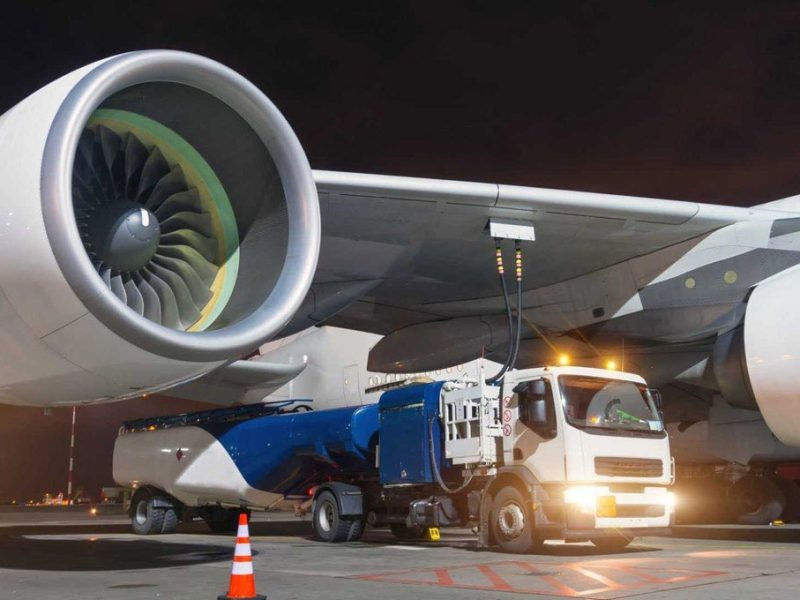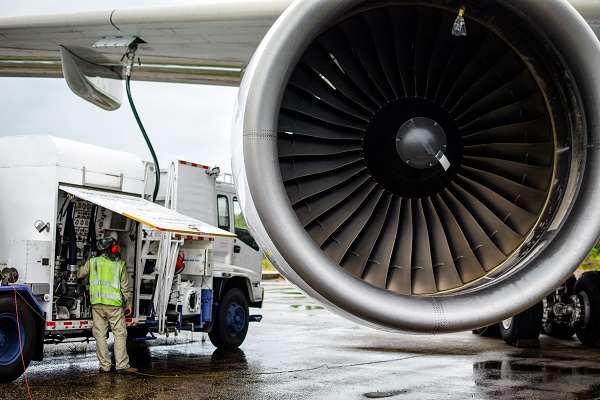Aviation fuel is a specialized type of petroleum-based fuel used to power aircraft. It is generally of a higher quality than fuels used in less critical applications, such as heating or road transport, and often contains additives to reduce the risk of icing or explosion due to high temperature, among other properties
Almost all aviation fuels are derived from crude oil in refineries. Most of partner’s refineries produce the kerosine type jet fuels for use in aviation turbine engines but only a handful of locations have the complex infrastructure required to create the more specialized grades of aviation gas Aviation turbine fuels are used for powering jet and turbo-prop engine aircraft and are not to be confused with Avgas.
Jet fuel, aviation turbine fuel (ATF), is a type of aviation fuel designed for use in aircraft powered by gas-turbine engines. It is colorless to straw-colored in appearance. Jet fuel is a mixture of a large number of different hydrocarbons. The range of their sizes (molecular weights or carbon numbers) is restricted by the requirements for the product, for example, the freezing point or smoke point. Kerosene-type jet fuel (including Jet fuel A and Jet A-1) has a carbon number distribution between about 8 and 16 (carbon atoms per molecule); wide-cut or naphtha-type jet fuel (including Jet B), between about 5 and 15. Both Jet fuel A and Jet A-1 have a flash point higher than 38 °C (100 °F), with an autoignition temperature of 210 °C (410 °F).
Outside former communist areas, there are currently two main grades of turbine fuel in use in civil commercial aviation: Jet A-1 and Jet A, both are kerosine type fuels. There is another grade of jet fuel, Jet B which is a wide cut kerosine (a blend of gasoline and kerosine) but it is rarely used except in very cold climates.
JET A-1
Jet A-1 is a kerosine grade of fuel suitable for most turbine engine aircraft. It is produced to a stringent internationally agreed standard, has a flash point above 38°C (100°F) and a freeze point maximum of -47°C. It is widely available outside the U.S.A. Jet A-1 meets the requirements of British specification DEF STAN 91-91 (Jet A-1), (formerly DERD 2494 (AVTUR)), ASTM specification D1655 (Jet A-1) and IATA Guidance Material (Kerosine Type), NATO Code F-35.
JET A
Jet A is a similar kerosine type of fuel, produced to an ASTM specification and normally only available in the U.S.A. It has the same flash point as Jet A-1 but a higher freeze point maximum (-40°C). It is supplied against the ASTM D1655 (Jet A) specification.
JP54
JP54 is an abbreviation for “Jet Propulsion, A1, Colonial Grade 54″. During the refining process only 15% of the crude oil is made up of JP54 the rest of the grade is used for different types of plastic. Developed by JP Morgan, Colonial grade JP54 was replaced by AVGAS also known as AVGAS100LL.
Actually, most jet fuel exported is “JP54” or “Colonial JP54”. It is similar to “Jet A” except the the Specific Energy is 18.4 mj/kg compared to that of 42.8 mj/kg of “Jet A”.




ivermectin otc – ivermectin 3 mg tablets order generic tegretol 200mg
order absorica generic – buy decadron generic generic zyvox 600mg
purchase amoxicillin – ipratropium 100 mcg cheap order ipratropium 100 mcg online cheap
zithromax 500mg us – buy azithromycin 250mg without prescription order bystolic generic
buy prednisolone 40mg online cheap – buy azithromycin 500mg online cheap progesterone online
neurontin price – cheap gabapentin buy sporanox for sale
lasix 100mg cost – where can i buy betnovate3 order betamethasone 20 gm creams
clavulanate cheap – purchase duloxetine pill cheap duloxetine 40mg
doxycycline over the counter – order acticlate online cheap purchase glucotrol online
augmentin drug – order cymbalta 40mg for sale order cymbalta 40mg generic
purchase rybelsus – cost vardenafil 20mg how to get periactin without a prescription
tizanidine pills – buy hydrochlorothiazide tablets oral microzide 25 mg
tadalafil 20mg canada – cialis 10mg brand sildenafil 50mg over the counter
sildenafil 50mg cost – order cialis 10mg cialis 5mg drug
atorvastatin 20mg brand – order atorvastatin 80mg sale buy lisinopril without prescription
cenforce 100mg for sale – chloroquine medication glucophage 1000mg brand
atorvastatin 10mg drug – lisinopril 2.5mg price lisinopril 2.5mg price
buy lipitor 40mg online cheap – buy prinivil zestril 10mg tablet
prilosec brand – atenolol 100mg canada atenolol 100mg drug
medrol cheap – cheap triamcinolone 10mg triamcinolone price
buy desloratadine paypal – claritin 10mg without prescription dapoxetine 90mg generic
buy cytotec without prescription – buy diltiazem without prescription diltiazem 180mg pills
zovirax where to buy – order allopurinol 300mg online cheap generic rosuvastatin 20mg
buy domperidone 10mg generic – motilium pills flexeril 15mg brand
buy motilium 10mg pills – buy tetracycline 250mg online cheap order flexeril sale
buy propranolol no prescription – propranolol drug methotrexate 5mg us
buy generic warfarin over the counter – losartan 25mg usa buy cozaar generic
buy generic levaquin online – how to get levaquin without a prescription ranitidine over the counter
order esomeprazole 20mg without prescription – purchase esomeprazole online sumatriptan cost
mobic 7.5mg pill – buy flomax pills flomax 0.4mg oral
order ondansetron 4mg pills – cheap aldactone 25mg zocor 10mg drug
cheap valacyclovir 500mg – buy diflucan cheap fluconazole for sale
order provigil 200mg pills buy provigil generic provigil 100mg generic brand provigil 200mg modafinil canada buy modafinil 200mg sale buy provigil 200mg without prescription
More posts like this would bring about the blogosphere more useful.
oral zithromax 500mg – buy zithromax 250mg sale flagyl 400mg cheap
semaglutide 14mg oral – periactin 4mg drug cyproheptadine 4 mg ca
motilium tablet – cost sumycin purchase flexeril for sale
buy generic inderal over the counter – plavix price buy methotrexate 2.5mg generic
cheap amoxil – diovan 160mg usa combivent ca
zithromax brand – order tindamax 500mg generic buy generic nebivolol
augmentin 375mg for sale – https://atbioinfo.com/ ampicillin over the counter
purchase nexium generic – https://anexamate.com/ buy nexium capsules
buy coumadin – https://coumamide.com/ buy losartan cheap
meloxicam ca – tenderness mobic generic
prednisone 20mg usa – https://apreplson.com/ order prednisone 5mg sale
where to buy over the counter ed pills – buy ed pills us buy ed pills without a prescription
where to buy amoxil without a prescription – combamoxi amoxil over the counter
oral fluconazole 100mg – https://gpdifluca.com/# diflucan brand
cenforce cheap – https://cenforcers.com/# cenforce 50mg drug
tadalafil dapoxetine tablets india – https://ciltadgn.com/ us cialis online pharmacy
ranitidine sale – https://aranitidine.com/# order ranitidine 150mg pill
overnight cialis delivery – https://strongtadafl.com/ buy cialis cheap fast delivery
buy viagra soft tabs – https://strongvpls.com/ cheap 100mg viagra
More content pieces like this would insinuate the интернет better. sitio web
I couldn’t turn down commenting. Well written! https://buyfastonl.com/
This is the gentle of writing I truly appreciate. https://ursxdol.com/cenforce-100-200-mg-ed/
More blogs like this would make the web better.
This website positively has all of the bumf and facts I needed adjacent to this subject and didn’t comprehend who to ask. https://prohnrg.com/product/rosuvastatin-for-sale/
I took away a great deal from this.
I absolutely admired the manner this was presented.
More posts like this would make the online space more useful. combien coute le viagra professional en pharmacie
Such a practical resource.
More articles like this would make the blogosphere better.
I really appreciated the style this was written.
More blogs like this would make the online space richer.
I absolutely admired the approach this was explained.
Thanks for posting. It’s excellent.
I’ll surely bookmark this page.
I truly liked the style this was laid out.
I gained useful knowledge from this.
Such a beneficial insight.
I gained useful knowledge from this.
Such a beneficial resource.
Greetings! Extremely gainful advice within this article! It’s the crumb changes which liking make the largest changes. Thanks a a quantity quest of sharing! https://ondactone.com/simvastatin/
The clarity in this piece is noteworthy.
The depth in this article is commendable.
Thanks recompense sharing. It’s top quality.
https://proisotrepl.com/product/domperidone/
This website really has all of the information and facts I needed there this subject and didn’t positive who to ask. http://www.orlandogamers.org/forum/member.php?action=profile&uid=29102
buy generic dapagliflozin over the counter – https://janozin.com/ buy dapagliflozin medication
purchase orlistat sale – buy xenical for sale order xenical 60mg pill
More posts like this would prosper the blogosphere more useful. http://wightsupport.com/forum/member.php?action=profile&uid=22056
You can protect yourself and your dearest nearby being cautious when buying panacea online. Some druggist’s websites control legally and provide convenience, secretiveness, sell for savings and safeguards to purchasing medicines. buy in TerbinaPharmacy https://terbinafines.com/product/prevacid.html prevacid
More articles like this would pretence of the blogosphere richer. online
The thoroughness in this break down is noteworthy.